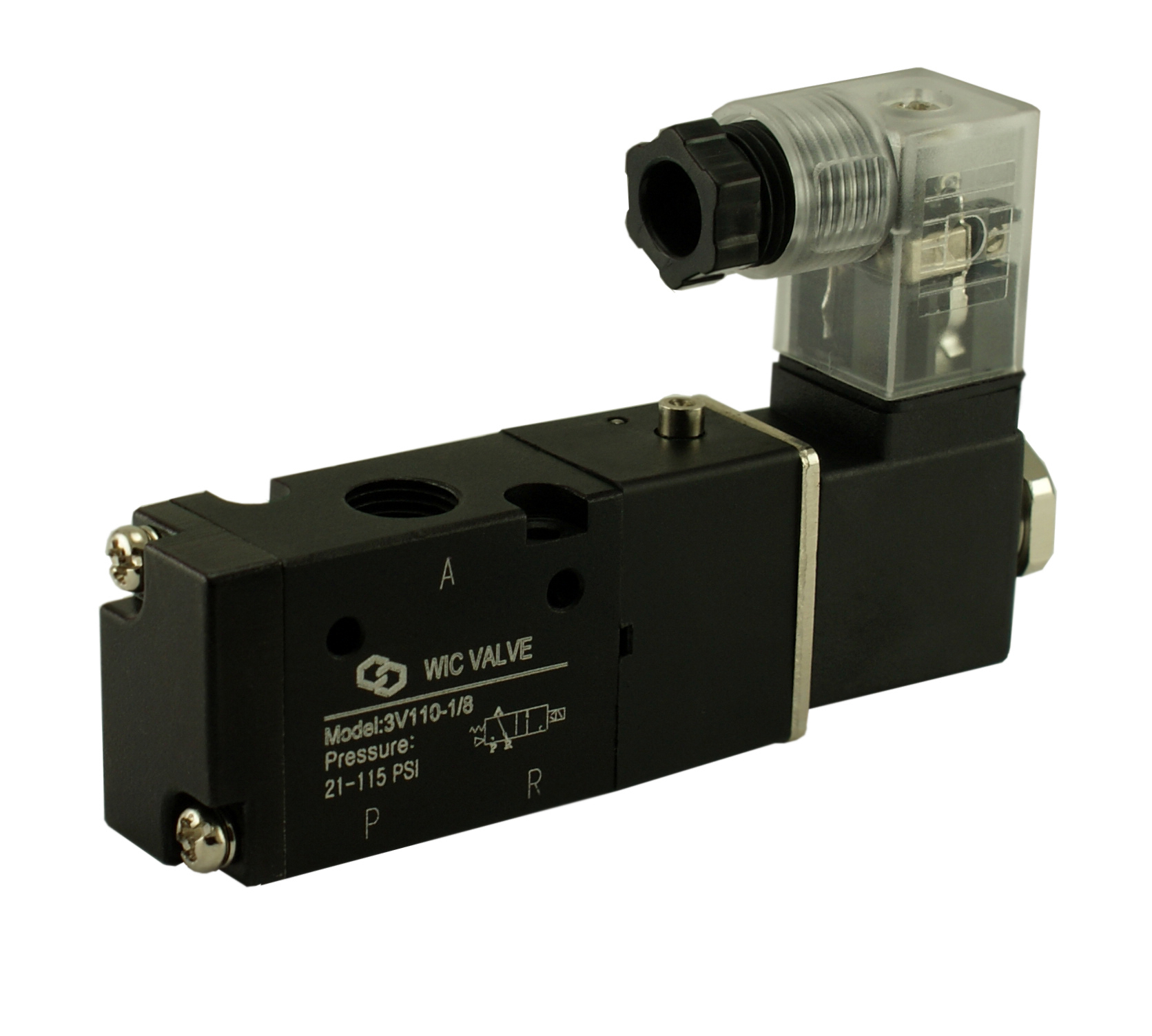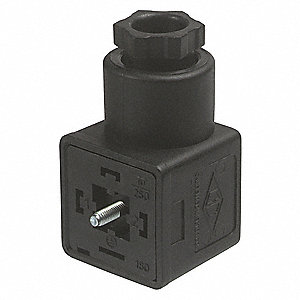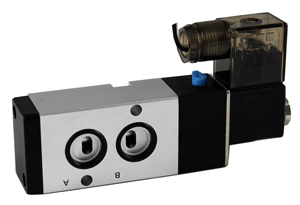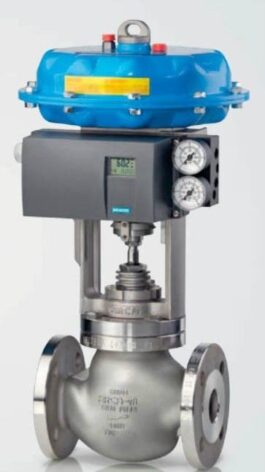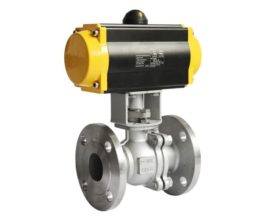Description
Solenoid valves are electromechanically operated valves. The valve is controlled by an electric current through a solenoid. In the case of a two-port valve, the flow is switched on or off. In the case of a three-port valve, the outflow is switched between the two outlet ports. Multiple solenoid valves can be placed together on a manifold.
A solenoid valve is a type of electromechanical device used to control the flow of fluids, gases, or other media in a variety of industrial applications. It consists of a coil, an armature, and a valve body. When an electrical current is applied to the coil, it generates a magnetic field that pulls the armature in. This allows the valve to open and fluid to flow through it. When the current is turned off, the magnetic field collapses, causing the armature to return to its original position and closing the valve.
Flow Control
One of the key advantages of solenoid valves is their ability to provide quick and precise control over fluid flow. This is achieved due to their rapid response times which can be as short as a few milliseconds. Additionally, solenoid valves are capable of functioning in a variety of environments, from high-pressure applications to corrosive or hazardous media.
There are several different types of solenoid valves, each with its unique features and applications. One common type is the direct-acting solenoid valve, where the coil directly controls the movement of the valve’s internal parts. These valves are typically used in low-pressure applications.
Coils
Another type is the pilot-operated solenoid valve, where the coil controls a smaller valve called the pilot valve, which in turn controls the movement of the main valve. Pilot-operated valves are commonly used in high-pressure applications. This is where a large amount of force is required to open or close the valve.
Solenoid valves can also be classified based on the number of ports or positions they have. A 2-way solenoid valve has two ports, an inlet, and an outlet, and is typically used to control the flow of a single fluid. On the other hand, a 3-way solenoid valve has three ports, allowing it to control the flow of two different fluids or direct flow in different directions.
Material
In addition to their functional classification, solenoid valves can also be categorized based on the materials they are made of and the types of media they can handle. For example, some valves are specifically designed to handle corrosive chemicals, while others are designed for food-grade applications.
Solenoid valves are widely used in a variety of industries, including manufacturing, oil and gas, water treatment, healthcare, and automotive. They are utilized in processes such as controlling the flow of liquid in pipelines. Additionally, it regulates the pressure of gases in pneumatic systems, operating irrigation systems, and even in applications like coffee machines or car washes.
it is worth mentioning that they can be further categorized based on their operational characteristics. Normally closed (NC) solenoid valves are designed to close when the electrical current is applied to the coil. Conversely, normally open (NO) solenoid valves open in response to the electrical current. These different configurations provide flexibility in various applications.
Reliability
Solenoid valves are designed to be efficient and reliable, allowing for precise control over the flow of fluids. Their compact and lightweight construction makes them suitable for a wide range of installations, even in limited spaces. They can be operated manually, electronically, or even remotely to suit specific needs.
In terms of maintenance, solenoid valves are generally low-maintenance devices. However, regular inspection and cleaning are recommended to ensure optimal performance and prevent any potential clogs or debris buildup that could hinder their functionality.
It is also important to consider factors such as pressure ratings, temperature ranges, and compatibility with different types of media (liquids, gases, or even high-viscosity fluids). Selecting the appropriate solenoid valve for a specific application requires a proper understanding of these factors, as well as the flow rate and intended use.
In summary, solenoid valves are electromechanical devices used for controlling the flow of fluids, gases, or other media in various industrial applications. They offer rapid response times, and precise control, and can be customized to meet specific requirements. By utilizing different types, operational characteristics, and construction materials, solenoid valves can address a wide range of needs across multiple industries.
Solenoid valves offer several advantages and disadvantages, which are important to consider when selecting and using them in different applications. Let’s explore both sides:
Cost Considerations
Solenoid valves can vary in cost depending on their size, material, quality, and additional features. High-quality solenoid valves may come at a higher price point. so, it is essential to balance cost with the specific requirements of the application.
It is worth noting that the advantages and disadvantages mentioned above are general considerations. The specific advantages and disadvantages may vary depending on the type, design, and manufacturer of the solenoid valve. Therefore, it is important to carefully evaluate the specific requirements. In addition, consult with experts or the manufacturer before making a selection.
Valve Variations
There are many valve design variations. Ordinary valves can have many ports and fluid paths. A 2-way valve, for example, has 2 ports; if the valve is open, then the two ports are connected. After, fluid may flow between the ports; if the valve is closed, then the ports are isolated. If the valve is open when the solenoid is not energized, then the valve is termed normally open (N.O.).
The valve is closed when the solenoid is not energized, then the valve is termed normally closed. There are also 3-way and more complicated designs. A 3-way valve has 3 ports; it connects one port to either of the two other ports (typically a supply port and an exhaust port).
Solenoid valves are also characterized by how they operate. A small solenoid can generate a limited force. If that force is sufficient to open and close the valve, then a direct-acting solenoid valve is possible. An approximate relationship between the required solenoid force Fs, the fluid pressure P, and the orifice area A for a direct-acting solenoid valve is
The solenoid valve (small black box at the top of the photo) with input air line (small green tube) is used to actuate a larger rack and pinion actuator (gray box) which controls the water pipe valve.
Higher Pressures?
When high pressures and large orifices are encountered, then high forces are required. To generate those forces, an internally piloted solenoid valve design may be possible. The line pressure is used to generate the high valve forces. A small solenoid controls how the line pressure is used.
Internally piloted valves are used in dishwashers and irrigation systems where the fluid is water, the pressure might be 80 psi (550 kPa) and the orifice diameter might be 3⁄4 in (19 mm).
In some solenoid valves, the solenoid acts directly on the main valve. Others use a small, complete solenoid valve, known as a pilot, to actuate a larger valve. The second type is a solenoid valve combined with a pneumatically actuated valve. They are sold and packaged as a single unit referred to as a solenoid valve.
Piloted valves require much less power to control, but they are noticeably slower. Piloted solenoids usually need full power at all times to open and stay open. Whereas a direct-acting solenoid may only need full power for a short period to open, and only low power to hold it.
Direct Acting Solenoid
Finally, a direct-acting solenoid valve typically operates in 5 to 10 milliseconds. The operation time of a piloted valve depends on its size; typical values are 15 to 150 milliseconds.
The power consumption and supply requirements of the solenoid vary with application; primarily determined by fluid pressure and line diameter.
Furthermore, a popular 3/4″ 150 psi sprinkler valve, intended for 24 VAC (50 – 60 Hz) residential systems, has a momentary inrush of 7.2 VA, and a holding power requirement of 4.6 VA.
Also, and comparatively, an industrial 1/2″ 10000 psi valve, intended for 12, 24, or 120 VAC systems in high-pressure fluid and cryogenic applications, has an inrush of 300 VA and a holding power of 22 VA. Neither valve lists a minimum pressure required to remain closed in the un-powered state.
Other types of valves include pneumatic and modulating

